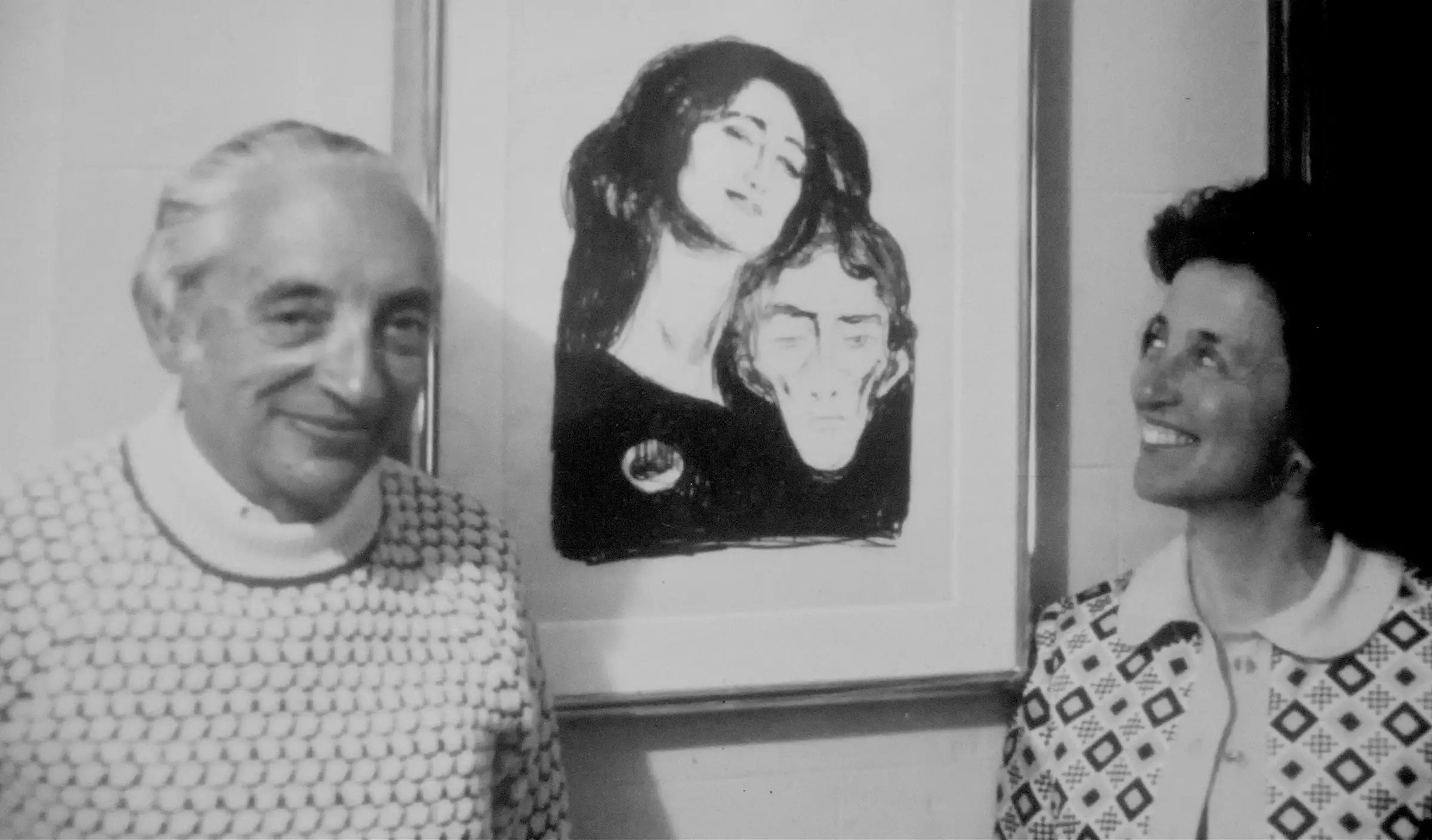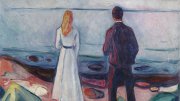A bequest from Philip A. Straus ’37 and his wife Lynn G. Straus of 62 prints and two paintings by Norwegian artist Edvard Munch (1863-1944) has made the Harvard Art Museums’ collection of that artist’s work “one of the largest and most significant” in the United States, according to an announcement this morning from the museums.
Though inspired by noted post-impressionist painters such as Paul Gauguin, Vincent Van Gogh, and Henri de Toulouse-Lautrec, Munch developed his own style, one that often conveys an inner state of mind. His work The Scream (Skrik in Norwegian), for instance, is often described as the categorical expression of human angst. Among the works in the recent Straus bequest is another iconic painting, Two Human Beings (The Lonely Ones), (1906-1908, see image above), that conveys a profound sense of isolation. “It is hard to overestimate the significance” of the painting, said Lynette Roth, the Daimler curator of the Busch-Reisinger Museum, in this morning’s announcement. “Capturing the tension between proximity and distance—spatial as well as emotional—the work addresses the universal theme of the human condition.”
Other important works in the recent gift, as described by the museums, include:
- Six prints from the series Two Human Beings (The Lonely Ones), ranging from 1894 to 1917, that join an impression the couple previously gifted in 1991. Together, they showcase the artist’s various woodcut and etching techniques and also demonstrate how he manipulated his jigsaw woodblocks to print different parts of a single work in different colors. Closely related to this group is the gift of Young Woman on the Beach (1896), a rare example of Munch’s brief exploration of the mezzotint technique.
- Three versions of Vampire II, dated 1895–1902, all either hand-colored or printed in color, join a black lithographic state from 1895 that the couple previously assisted with purchasing. These prints show how Munch sometimes combined lithographs with hand coloring and also used woodblocks to add color.
- Four impressions of Madonna, dated 1895–1902, join a black lithographic state and a drypoint from 1894 that the couple previously assisted with purchasing. The lithographic prints show a range of examples of hand-applied color (drawn/painted) and printed color.
- One impression of the woodcut Woman’s Head against the Shore (1899) joins two other impressions from the same year, both previous gifts from the Strauses: Woman’s Head against the Shore, printed in turquoise-green and pale and dark orange inks; and Woman’s Head against the Shore, printed in red and three different colors of green ink. These prints show how Munch selectively printed his jigsaw woodblocks.
- Four different self-portraits are the first such representations of the artist to enter the collection.
- There are also rare examples of prints that Munch printed himself with his small hand-crank press, including Melancholy II (1898), a woodcut printed in black, red, blue, and yellow inks.
Harvard’s teaching museums have received multiple gifts from the Strauses during the past four decades, including: Munch artworks (117 in total, including those announced today); donations or enabling support to purchase works by Max Beckmann, Georges Braque, Alexander Calder, Emil Nolde, and others; the endowment of several conservation and curatorial positions; and a $7.5-million endowment for the Straus Center for Conservation and Technical Studies, first established in 1928 as the department of technical research by Fogg Museum director Edward Forbes, and renamed in honor of the couple in the 1990s. Philip Straus, an investment adviser and portfolio manager, died in 2004. His wife, who passed in 2023, donated two other important paintings in her husband’s memory in 2012, Winter in Kragerø (1915) and Inger in a Red Dress (1896).

1969. | PHOTOGRAPH Courtesy OF Philip A. Straus Jr. AND THE HARVARD ART MUSEUMS
“We are immensely grateful to Philip and Lynn Straus for their generosity and stewardship over these many years,” said Sarah Ganz Blythe, the museums’ Cabot director, in today’s announcement. “Their enthusiasm for the work of Edvard Munch ensures generations of students and visitors can experience and study his prints and paintings here in Cambridge. Through their distinct style of collecting Munch’s prints—seeking out and acquiring multiple images of the same theme—they created a collection that affords deep insights into the artist’s practice and is therefore a perfect match for a university museum with a strong teaching and research mission.”
Edvard Munch, Technically Speaking, an exhibition opening at the museums on March 7, will include many of the recently donated works, as well as others in the museums’ collection of 8 paintings and 134 prints by the artist, as well as important loans from the Munch Museum in Oslo. An opening lecture, tours, gallery talks, and a film screening will be offered in conjunction with the exhibition.









